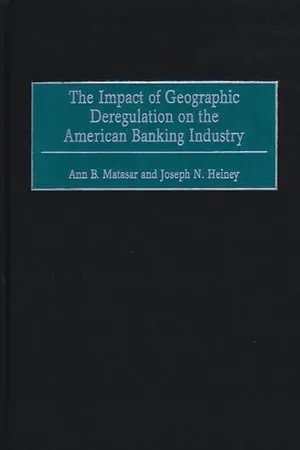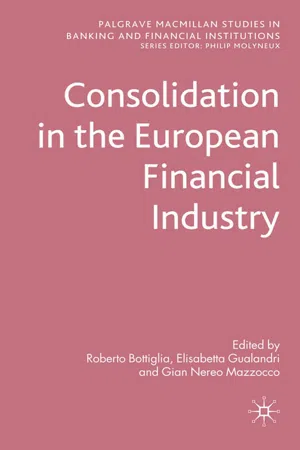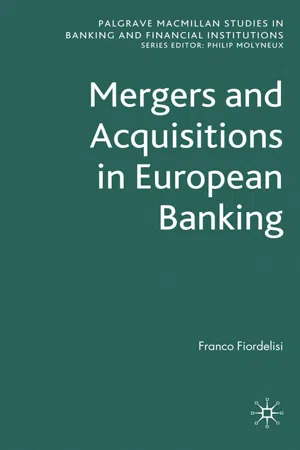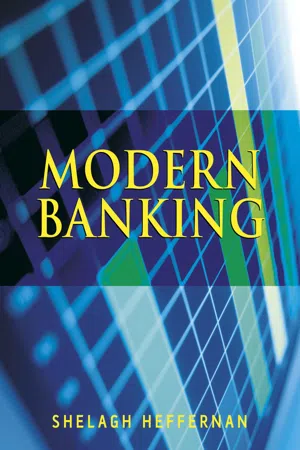Economics
Bank Consolidation
Bank consolidation refers to the process of two or more banks merging or one bank acquiring another. This can lead to a reduction in the number of banks in a market, potentially increasing market concentration. Consolidation can result in cost savings, improved efficiency, and expanded geographic reach for the surviving institution. However, it may also lead to reduced competition and potential negative impacts on consumers.
Written by Perlego with AI-assistance
Related key terms
1 of 5
8 Key excerpts on "Bank Consolidation"
- Takatoshi Ito, Andrew K. Rose, Takatoshi Ito, Andrew K. Rose(Authors)
- 2009(Publication Date)
- University of Chicago Press(Publisher)
First, consolidation may increase or decrease e ffi ciency in various ways. A consolidated bank may be able to achieve a scale or scope economy. It may also improve X -e ffi ciency by spreading superior acquirers’ managerial skills over targets. On the other hand, it may take considerable time and costs to integrate di ff erent accounting and information systems, ways of doing business, and corporate cultures. Second, consolidation may change the availability of loans and other fi-nancial services to small- and medium-sized enterprises (SMEs), though such changes may not be intended either by acquirers or targets. If consol-idation improves e ffi ciency, a more e ffi cient consolidated bank may be able to serve more customers, including SMEs. On the other hand, if a large bank finds it costly to process relationship-based information due to its organizational complexity, a consolidated bank may reduce loans to the SMEs that are informationally opaque (Berger, Demsetz, and Strahan 1999). Consolidated banks may also increase or reduce other services, in-cluding fee businesses, according to their comparative advantages. Third, consolidation may strengthen market power, enabling the consol-idated bank to raise loan interest rates or lower deposit interest rates. This is likely to occur when acquirers and targets operate within the same local market (e.g., Berger, Demsetz, and Strahan 1999). Consolidation of Banks in Japan: Causes and Consequences 295 Fourth, consolidation may improve or deteriorate healthiness. Although regulators may promote consolidations by weak banks, it is not clear whether weak banks can restore healthiness just through consolidation. On one hand, a consolidated bank may gain from risk diversification through investing various areas and industries (Berger, Demsetz, and Stra-han 1999). In addition, an acquirer may apply its superior risk manage-ment skills to a target.- eBook - PDF
Unsettled Account
The Evolution of Banking in the Industrialized World since 1800
- Richard S. Grossman(Author)
- 2010(Publication Date)
- Princeton University Press(Publisher)
The literature consider-ing the consequences of increased concentration on the banking system of the United States in the last two decades of the twentieth century is decidedly mixed (Berger, Demsetz, and Strahan 1999). The Urge to Merge To discover the motives for bank mergers, we need look no further than their consequences, discussed in the previous section, which can be grouped under two broad headings: efficiency and market power. 3 Although these motives are presumably ever-present, the periodic emer-gence of merger waves suggests that they wax and wane. Because mergers involve both buyers and sellers, I consider the motives of each, starting with acquirers. 3 This categorization ignores several objectives other than maximizing firm profits, such as empire-building or pay maximization on the part of managers. Hughes et al. (2003), Group of Ten (2001: 66ff.). Merger Movements • 113 One motive facing potential acquirers is economies of scale and scope. Large banks may have efficiency advantages over smaller banks. First, by conducting more business, they may be able to do so at a lower average cost (i.e., economies of scale), giving them a competitive advantage over smaller rivals. Second, merely by having more resources at their disposal, they may be better able to service the borrowing needs of larger firms. Third, larger banks may be better able to diversify, both geographically (through branch networks) and functionally (across product lines), than smaller banks. Economies of scale may be more important at some times and places than others. Economic growth, in particular the kind that accompanies industrialization, and that often involves an increase in average firm size, may increase the returns to economies of scale. Larger firms usually have greater financing requirements than smaller ones, since they involve higher concentrations of capital. - Ann B. Matasar, Joseph N. Heiney(Authors)
- 2002(Publication Date)
- Praeger(Publisher)
Chapter 2 e The Economic and Financial Health of America's Banks: The Effects of Consolidation on the Private Sector The number of American banks that ushered in the new millennium was substantially diminished by the ongoing consolidation occurring in the American banking industry during the 1990s. To what extent this repre- sented a healthy and desirable phenomenon was not immediately appar- ent or assured. As Peter Rose noted, "Relative to most other controversial areas in banking, the volume of research focusing upon interstate banking still remains comparatively limited. Few issues can be really marked down as 'decided,' and the current body of evidence must be considered 'thin' by conventional scientific standards." 1 Using data collected by the FDIC for all insured banks, which encom- pass all domestic banks as well as any foreign banks doing retail banking in the United States, it is now possible to develop a composite picture of the fi- nancial health, particularly the profitability and risk exposure, of American banks at the end of the 20th century and to determine to what degree, if any, this condition has improved, deteriorated, or remained unchanged in the era of consolidation. 22 The Impact of Geographic Deregulation AGGREGATE CONDITION AND INCOME DATA Net Income Net income or profitability is the key component of any business's pres- ent fortunes and future viability As profit-making institutions, banks are no exception to this rule. Banks obtain their operating income from a variety of sources, including interest and fees on loans, income from the investment securities held in the bank's own portfolio, underwriting income associated with leases, fees for fiduciary activities, earnings on foreign exchange transactions, service fees, and noninterest income.- R. Bottiglia, E. Gualandri, G. Mazzocco, R. Bottiglia, E. Gualandri, G. Mazzocco(Authors)
- 2010(Publication Date)
- Palgrave Macmillan(Publisher)
In view of its significance, the phenomenon of M&A operations in the banking and financial industries has been studied extensively and has been the subject of a large number of empirical investigations, intended to meas- ure its impacts from two main points of view: the first is macroeconomic and deals mainly with the effect of these operations on the structure of the finan- cial system and the relative implications (competition mechanisms, access 2 Consolidation in the European Financial Industry to credit for various types of clientele and relative costs), while the second is more strictly corporate in nature and focuses on strategic factors and an analysis of the potential benefits, especially in terms of value creation. Within these two types of approach, a very large number of studies have set out to examine specific or partial aspects of the phenomenon, such as the extent to which it has affected the various countries or different types of intermediaries (in terms of size or area of business), the reasons, causes and implications of financial consolidation operations, their impact on external supervision and/or internal governance and control systems, and so on. In the following pages we will attempt to provide a general definition of the phenomenon, many specific aspects of which will then be analysed in the contributions of the various chapter authors. 1.2 M&A operations in the banking sector In view of banks’ centrality to the structure of financial systems everywhere, it is useful to begin by providing a few brief data on the concentration pro- cess that has taken place in the banking sector, mainly by means of M&A operations. As can be seen in Tables 1.1, 1.2, 1.3 and 1.4, which summarise the main aspects of the phenomenon, the rate of M&A operations has been very high, in both Europe and the USA.- eBook - ePub
The Bank Merger Wave: The Economic Causes and Social Consequences of Financial Consolidation
The Economic Causes and Social Consequences of Financial Consolidation
- Gary Dymski(Author)
- 2016(Publication Date)
- Routledge(Publisher)
Countering these “static” or point-in-time results is a series of even more recent studies arguing, first, that no net shift away from small-business lending has occurred because of the sheer size (if smaller relative commitment) of large merging banks; and, second, that new lenders will emerge to fill in any gaps left by large banks’ absorption of smaller lenders. The most comprehensive analysis, by Berger, Saunders, Scalise, and Udell (1997), covers 6,000 mergers and acquisitions involving 10,000 banks. These authors find that the “static effects that reduce small business lending are mostly offset by the reactions of other banks and, in some cases, also by the refocused efforts of the consolidating institutions themselves.”The robust U.S. economy of the late 1990s is hardly the best environment in which to examine the possibility that bank concentration may tighten credit constraints on small business. Banks are seeking out creditworthy borrowers, and few small firms feel credit constrained. A recent assessment of bank loan growth (Gilligan 1997) found that growth rates in business loans under $100,000 were strongest at small banks and at the very largest banks. In the last recession period (1989–1991), banks’ lending fell more to small businesses than to larger businesses; and it took longer to recover (Berger, Kashyap, and Scalise 1995). The next recession may give a clearer picture of the impact of Bank Consolidation on small businesses. In any event, if large banks are strengthening their commitment to small-business lending, they are lending in a different way. Jeep Bryant, First Union spokesman, commented to the Wall Street Journal (April 14, 1998) that his institution has doubled its commitment to small-business lending; in the process, “We have driven down the cost of providing small business loans by automating much of the underwriting process.” This automation of underwriting is known as credit scoring, a topic discussed in chapter 11 .Bank Consolidation and Bank Branch Locations
One ongoing trend in banking is the realignment of bank branch networks associated with the reorganization of the industry. Branch densities in mature banking markets have declined because of consolidation (as branches are closed), the centralization of many banks’ loan decision-making, and banks’ orientation toward upper-income customers. Community Reinvestment Act considerations have, at the same time, led banks to maintain a presence in some lower-income and minority neighborhoods. Banks have opened, and continue to open, branches in emerging suburban and exurban markets, in an effort to capture the high-value-added customers who are purchasing homes in these new areas. - eBook - ePub
A Century of Banking Consolidation in Europe
The History and Archives of Mergers and Acquisitions
- Manfred Pohl, Teresa Tortella(Authors)
- 2017(Publication Date)
- Routledge(Publisher)
increased internationalism and universalism. In some respects, the history of banking consolidation is therefore the history of a select group of large banks which have managed to maintain or to gain dominance over the industry, often - though not always - through mergers and acquisitions. In other respects, however, it overlaps with the history of the banking sector and its interaction with the economy as a whole.The object of this chapter is to highlight some of the general trends underlying this consolidation process. Given the space available and the huge scale of the subject, such a presentation can only be general and tentative, and serve as a general introduction to the more specific topics which are discussed in subsequent chapters of this book. Despite the apparent common outcome of a century of consolidation in European banking, different routes have been followed and there still remain substantial differences. Moreover, consolidation is an ongoing process, which has gathered pace in the late 1990s.1 The emphasis of the paper will be on the common features displayed by the European experience rather than on national peculiarities. However, in order to take account of the diversity of this European experience, a broad comparative perspective will be maintained throughout. To this end, six questions will be addressed, each related to commonly perceived trends in the consolidation movement in European banking.1. How have Europe’s largest banks reached their dominant position?
Table 1.1 The 30 largest European banks, 1995
Sources:Times 1,000, Banking Almanac.Great Britain France Germany Italy HSBC Barclays Natwest Abbey National Lloyds Crédit Lyonnais Crédit Agricole BNP Société Générale Paribas Suez Deutsche Dresdner WestLB Commerz Bayer. Vereinsbank Bayer. Landesbank Inst. Bancario S. Paolo di Torino Banca Nazionale del Lavoro Banco di Roma Banca Comerciale Italiana Spain Holland Belgium Switzerland Hispano Central Bilbao-Vizcaya Santander ABN AMRO Rabobank Générale de Banque UBS SBS Crédit Suisse Let us first consider the end-result, at least for the time being, of a century of banking consolidation. Table 1.1 lists the 30 largest European banks in 1995, arranged by country of origin. Looking at the table from the perspective of consolidation, that is of a group of dominant core banks, three routes to the top can be identified.2 - eBook - PDF
- F. Fiordelisi(Author)
- 2015(Publication Date)
- Palgrave Macmillan(Publisher)
these deals may lead the banking market to an increased con- centration making the risk of diminishing competitive pres- sures concrete; b. large banks may collude and set unfavourable price to custom- ers to increase their profits. To face these risks, the anti-trust authorities carefully monitor M&A deals among banks in order to prevent these “bad outcomes.” Why Do Banks Merge? 53 Revenue enhancements may be achieved by exploiting operational synergies, such as network externalities. 3 In banking, network exter- nalities are mainly related to the distribution channels: the merger between two banks with complementary distribution channels – as for example, on-line and branch based, respectively – may increase the product/service value to individual customers. This may lead custom- ers to intensify interactions so as to facilitate product cross-selling, to improve the bank image and also increase the number of customers. Similarly, revenue enhancements may also be achieved by leveraging marketing capabilities 4 : merging banks may be able to take advantage of each other’s marketing capabilities; for example, using established distribution channels of the other bank in another country. 2. cost savings. M&A deals occur since, by combining the acquirer and target bank ‘s activities, there are some cost efficiency savings due to expense reduction in various business areas (e.g. marketing, sales and distribution, human resource management, etc). Cost sav- ings may be realized by: a. reducing excess capacity: for banks with an excess capacity, an M&A deal can help rationalize the production and take out the excess capacity by reducing fixed costs. A common case in banking concerns the branch network: in the 1990s, banks increased substantially the number of branches thus experienc- ing an excess of capacity over the 2000s. M&As were often used to rationalize the branch network of the two merging compa- nies. - eBook - PDF
- Shelagh Heffernan(Author)
- 2005(Publication Date)
- Wiley(Publisher)
Furthermore, most banks produce multiple outputs, namely, a fairly broad range of financial services. These observations make it difficult to apply the term ‘‘economies of scale’’ in the financial sector, which may partly explain the widely varying empirical evidence on the degree to which economies of scale exist. Yet they are normally cited as one of the key reasons why a merger between financial institutions will be a profitable one for shareholders. The concept of economies of scope is another one that, employed loosely, can lead to unrealistic expectations of the benefits of a merger or acquisition. Economies of Scope exist if the joint production cost of producing two or more outputs is lower than if the products are produced separately. For example, suppose a bank offers three services to its customers: deposit, loans and a payments service. If a bank can supply these services more cheaply through a joint production process it is said to enjoy economies of scope. The core banking business, where the bank intermediates between borrowers and lenders by lending out a percentage of its deposits, is one example of economies of scope. Though the payments service offered by banks is a byproduct of intermediation, it is not obvious that lower costs result from the joint production of this service with intermediation. This may explain why some countries, such as the UK, have a highly integrated payments system while in others (e.g. the USA) it is more fragmented (see Chapter 1). The business policy term for economies of scope is Synergy, though synergy may embrace broader ideas such as the newly formed, larger firm reducing input prices by exploiting its more powerful influence on suppliers, thereby enhancing profitabil- ity.
Index pages curate the most relevant extracts from our library of academic textbooks. They’ve been created using an in-house natural language model (NLM), each adding context and meaning to key research topics.







